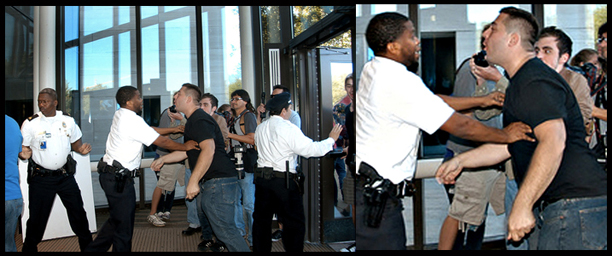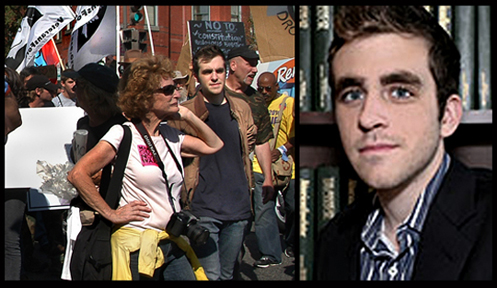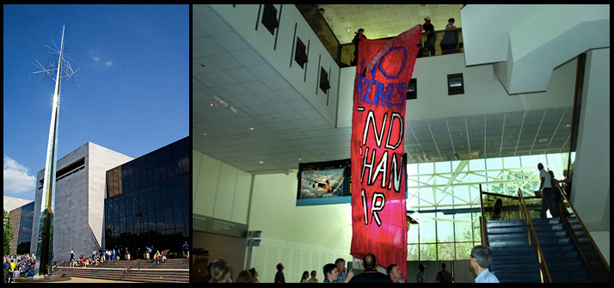As far as anyone knew I was part of this cause — a cause that I had infiltrated the day before in order to mock and undermine in the pages of The American Spectator — and I wasn’t giving up before I had my story.
Patrick Howley
Editorial Assistant, The American Spectator
Here’s a story from the annals of fools posing as journalists.
After a pepper spray melee October 8th at the Smithsonian National Air and Space Museum in Washington DC in which several people I know were painfully sprayed, it was revealed that one of at least two provocateurs whipping up the guards and cops was a writer from a right-wing magazine, The American Spectator.
Op-ed News photographer Cheryl Biren was at the museum and noticed a beefy man in a black t-shirt whose aggressive actions seemed to her the actions of a “provocateur.” She sent out a query with 27 shots of the man to see if anyone knew who he was. He’s seen charging a guard in Biren’s photo below; the man directly behind him in a tan jacket is American Spectator Editorial Assistant Patrick Howley.
Those of us who have worked for decades as non-violent antiwar peace activists talk about these sorts of individuals in cretinous terms. They are the bane of our existence. Why? Because they intentionally whip things up to a frenzy to distract from a protest’s intended message. They do this by provoking the police into what might be termed cop-riot-mode where they feel the need to indiscriminately whack people with batons and/or spray them with pepper spray.
This is exactly what happened October 8th at the Air and Space Museum, where these men and possibly others shoved their way into the museum lobby and went a long way toward creating a melee out of what was to be a moral protest of the US drone program.
 Patrick Howley is behind the beefy man, here, shoving his way into the museum lobby. Photo: Cheryl Biren/opednews.com
Patrick Howley is behind the beefy man, here, shoving his way into the museum lobby. Photo: Cheryl Biren/opednews.com
The Economist, a respected international news magazine, wrote about Howley’s operation in the Air and Space Museum and called him a “conservative jackass.” The online Economist writer M.S. was making both a reference to the TV show “Jackass,” where people do stupid, dangerous things on camera, and, presumably, reflecting on Howley’s thinking as he was rushing around in the Air and Space Museum like John Wayne hitting the beach at Iwo Jima.
Howley, then, wrote an article in The American Spectator on-line bragging about his agent provocateur mission. In an odd turnabout, he ends the article by stroking the very cops he provoked to pepper spray him. “I deserved to get a face full of high-grade pepper,” he writes, “and the guards who sprayed me acted with more courage than I saw from any of the protesters.”
 Patrick Howley marching with protesters to the museum and his ID photo from the magazine. Photo at left: Cheryl Biren/opednews
Patrick Howley marching with protesters to the museum and his ID photo from the magazine. Photo at left: Cheryl Biren/opednews
As for his journalistic ethics, M.S. from The Economist says it best:
“It’s an interesting question whether provoking a conflict under false pretenses is more or less culpable than simply inventing things that never happened, as Stephen Glass and Jayson Blair did. …It’s reminiscent of the videos in which James O’Keeffe dressed up as a bizarre version of a 1970s neoconservative’s ethnic-ghetto pimp bogeyman, in order to reveal how ACORN employees would respond to being confronted with a bizarre version of a 1970s neoconservative’s ethnic-ghetto pimp bogeyman.”
The obvious question is why would a young aspiring journalist go to the trouble to do all this — and then brag about it? It clearly has something to do with the dehumanized and reductive view deeply etched in this young man’s mind as to who the men and women are that he’s trying so hard to “mock and undermine.” Thanks to his own bizarre efforts, in the end he may be the one who is “mocked and undermined.”
It’s still unclear who the energetic beefy man in the black t-shirt is. Despite being pepper-sprayed directly in the face, photographer Biren dedicated herself courageously to taking his picture. “I was shooting in-between choking and saline flushes,” she says. A week later she was still complaining of a sore throat. She, of course, was only doing her First Amendment-protected job when she was pepper sprayed by upset museum guards.
Biren wrote that the black t-shirted man “escalated things right before the spraying and then continued to agitate. …At first, I thought he was creating a distraction so that the Howley punk could get in, but he was getting in the cops’ face later – even a SWAT team member – and they didn’t do anything to him. I know sometimes it’s not in their interest to arrest, but I really couldn’t believe they didn’t take him down, especially since they had SWAT backup. He even looks like a cop. But he could just be a right-wing agitator. I thought he might be a vet, but no one seemed to know him.”
As for Howley, thanks to his sharing, we know a lot about him.
What is The American Spectator?
The American Spectator is a perennial conservative favorite that I sometimes glance through over a cup of coffee at the local Barnes & Noble. I never purchase a copy and do the same with other conservative publications. It traces its history back to 1924. R. Emmett Tyrrell, Jr. has been its leading light for some time and he’s editor-in-chief. He once wrote a book ridiculing President Bill Clinton titled Boy Clinton: the Political Biography. Tyrrell is a lively, aggressive writer with considerable far-right edge. He takes no prisoners.
In his “Continuing Crisis” column in the October issue, he has great, gossipy fun with Barack Obama’s unfortunate “illegal alien” uncle “arrested outside the Chicken Bone Saloon in Framingham, Massachusetts.” He says, “Our president’s puniness continues to shrink.” He suggests the Sofitil Hotel rape victim Nafissatou Diallo should “become a spokeswoman for the National Organization for Women” and she should replace Barbara Walters on The View. The magazine’s legal counsel is listed as: “Solitary, Poor, Nasty, Brutish & Short.”
The publisher is Alfred S. Regnery, author of a 2008 book called Upstream: The Ascendance of American Conservatism. It sounds interesting, and I may glean through a copy soon over a Barnes & Noble latte. I’m sure it starts with Richard Viguerie and his direct mail campaigns of the 1970s. Some refer to Viguerie as “the funding father” of the modern conservative movement. Ronald Reagan probably has top star billing in the saga.
Also in the October issue, there’s an interesting essay by historian Robert W. Merry about Andrew Jackson. Merry gives the history, then, ham-handedly co-opts Jackson’s manly populism for cleaning up the fat-cat banks as a model for the Tea Bag right. While it’s true Jackson is still burning in Hell for the Trail Of Tears, he does have left-leaning populist qualities. I don’t know how else to say this, when it came to banks oppressing ordinary, working white people, Jackson was a true champion.
So one could take the same historic material Merry presents and cite Jackson’s populist, anti-banker attitudes as a model for a straight-shooting, people-oriented leadership style willing to get tough with the 30-year regime of government-supported, de-regulated Wall Street piracy that led to the current economic debacle. FDR revered Jackson for his honest, no-compromise advocacy of “the people” versus the Banks. So, instead of the “Tea Party President” that Merry touts, Jackson’s populist, anti-bank activism could make him a great “Occupy President.” In fact, maybe President Obama should walk across Pennsylvania Avenue into Lafayette Park and commune with the Jackson statue there.
In the “About” page of The American Spectator website, the editorial staff beyond Regnery and Tyrrell, Jr., amounts to an Editorial Director, an Associate Editor, a Managing Editor and, last but not least, Editorial Assistant Patrick Howley. Of course, they’re all white males.
I tried to call Howley to ask him, “What were you thinking, dude?” But I could not reach him. He may be hiding out in a secret location. I did get Managing Editor Joseph Lawler on the phone and asked him if he would comment on the Howley story. He very politely said he had been out of the country and, “I don’t have anything to say about that.”
He said I would have to go higher for a comment, and he gave me Editorial Director Wladyslaw Pleszczynski’s email address. I sent him a cordial query, but so far, I have gotten no response. Pleszczynski has a piece in the October issue about returning to Poland to delight in how much our western, free-market lifestyle has become “a new normal” there.
Why Agents Provocateur Are the Lowest Of the Low
Antiwar activists are always thinking about and discussing the potential for provocateur meddling in protests, whether the culprits are actual cops or just hangers-on with some police agency — or, as in Howley’s case, an ideologically driven journalist. Despite Howley’s fantasies, there’s nothing romantic or heroic about a provocateur. Plus, it needs to be noted Howley’s antics are child’s play compared to blatantly unconstitutional and violent provocateur actions in the past under the auspices of COINTELPRO and other government efforts.
In our Veterans For Peace chapter in Philadelphia, for example, we’ve had several men over the years saunter into our meetings who we wondered about. One, back during the Gulf War, eventually left little doubt. No one knew of him before he showed up one day as a veteran with a cool fatigue jacket complete with provocative patches all over it. The outfit looked like it came from a Hollywood wardrobe unit tasked with fitting an actor out as a “veteran antiwar activist.”
He helped out one evening making signs for a Washington DC demo and started to suggest some pretty dicey civil disobedience. After that, we all began to look at him strangely. He picked up on our looks and, soon, disappeared; we never saw him again.
This kind of two-faced individual is a tool of delusional thinking that people who have the clarity to think and exercise their Constitutional rights are dangerous subversives. Our man was probably playing out some cheap plot in which he thought he was, maybe, Al Pacino in Serpico — when really he was a sad man trying to encourage violent acts from people with no inclination for them at all.
It’s also possible provocateurs are just bums who need the chump change provided by whoever their handlers may be – hungry and desperate individuals like the drug addict who would steal from his grandmother. Or maybe all the undercover intrigue and bonding is a lift for a sad, beaten-down ego.
As for the man in the black t-shirt, Veterans For Peace organizer Tarak Kauff says it became clear there was something rotten about him.
“I had been suspicious of this guy for at least a day prior to this incident at the Air and Space. He just didn’t seem right and had made a few comments at the general assembly which were kind of provocateur-like, as if he were trying to influence the group towards a more wild anarchist style resistance. But he didn’t seem to have the politics to go with it.”
After Biren’s photos came out, suspicions began to rise.
“In the evening assembly,” Kauff says, “he made another remark about how we need to stand up to the cops, etc. So, then, when he appeared again later that evening, Dennis Trainer and I walked over to the tent he was sitting outside of and asked him to leave and not come back. This he did after some mild protestation, but we were pretty firm on that he had to leave. Interesting, he just got up and left. Didn’t take anything with him, not the tent or anything. He just left.”
As a would-be journalist, Howley’s case is more interesting. Although he’s on the staff of the magazine, the on-line criteria for an internship at The American Spectator is instructive:
“The American Spectator takes pride in its history of providing meaningful experience to young conservatives. Duties don’t involve sorting mail or making copies, but rather giving you the tools and clips necessary to succeed as a journalist.”
Maybe Howley’s variety of an undercover, “false flag” operation is the kind of “meaningful experience” that goes along with R. Emmett Tyrrell Jr.’s aggressive, far right style. It would not surprise me if Tyrrell shares Howley’s view that leftist protesters are worthless wimps. Howley suggests in his article that non-violent, peaceful protest is not very manly or noble.
Real men, we are to presume from his actions, bust into a place and run around like a headless chicken on adrenaline. And if the armed Tea Bagger demos of last year are any kind of model, real men protesters prefer the Second Amendment to the First and might pack heat to a demonstration like the one at the Air and Space Museum. (How real women should act in a protest situation doesn’t seem to be an issue for Howley, except to make note of all the “attractive 20-year old girls” in the march.)
Whatever Howley’s real story is, he should be ashamed of himself. If his magazine has any professional pride of journalism at all, it will fire him and, further, taint him in conservative editorial circles, making him stand in an unemployment line. Charlie Grapsy of the blog FireDogLake put it this way:
“As a result of Howley’s activities a large number of people were subjected to pepper-spray attacks including journalists and tourists who had nothing to do with the protest. … It is highly likely that the events that occurred would not have taken the turn they did if it were not for Howley’s admitted adventure in an effort to discredit the Occupy movement.”
These are pretty serious charges.
The Drone Question Gets Upstaged
The non-violent activists went to the Air and Space Museum that day for a purpose: To address the Museum’s exhibit on drones, for which it offers docent and high school tours. The protest involved the dropping of a large banner in the lobby intended to question the morally dubious, secret drone programs in Afghanistan and Pakistan. Drones are a burgeoning weapons system and a central component of the Pentagon’s future war doctrine; soon they will be employed in secret potentially everywhere. Rick Perry wants to use them on the Texas-Mexican border for surveillance, but their use for lethal missions is always just around the corner.
Drones, of course, were instrumental in locating and disabling the convoy a fleeing Muammar Gaddafi was in. The drone warriors, then, turned things over to a sadistic, blood-thirsty mob to gleefully abuse the run-down despot so, reportedly, in an ambulance, a young Libyan with a New York Yankee cap could finally shoot him in the head a couple times. Our part — the drone work — was nice and clean so our leaders and many Americans could rejoice at yet another successful “hit” contracted out of the White House.
No one in the mainstream media or government — certainly not the Air and Space Museum — really wants to deal with the controversial moral issues the rise of drone warfare raise.
 The Air and Space Museum and the lobby banner that says "No Drones, End Afghan War." Photo at right: Bill Perry.
The Air and Space Museum and the lobby banner that says "No Drones, End Afghan War." Photo at right: Bill Perry.
 Three drones featured in the exhibit: The RQ-7A tactical surveillance drone, the Predator killer drone, and a prototype X45A
Three drones featured in the exhibit: The RQ-7A tactical surveillance drone, the Predator killer drone, and a prototype X45A
 The protested moral issue: A victim of a drone attack in Pakistan and a drone pilot at work. Photo at left: Daniel Berehulak/Getty
The protested moral issue: A victim of a drone attack in Pakistan and a drone pilot at work. Photo at left: Daniel Berehulak/Getty
The behavior of Howley and others less forthcoming about their provocateur actions were successful in shifting the protest story from the moral questions about drones to a silly melee with guards and cops. Look at the expression and body language of the guard in Biren’s shot at the top where the beefy man in the black t-shirt, with Howley behind him, is shoving his way into this man’s space. This guard is being pushed to his limit; he’s becoming scared of losing control (and maybe his job) and he will begin to respond more violently than necessary, which will have a contagious effect on his comrades. A lobby melee has become the story.
It’s a case of the people trying to call attention to an immoral US policy of remote killing machines being seen as more “criminal” than the secret lethal policy itself. In this respect, the actions of Patrick Howley and his comrades exacerbated the shift in culpability — whether they were just exploiting the guards’ reactions or whether they were possibly working in cahoots with SWAT cops.
Howley should be banished from journalism until he appropriately atones for the actions he is apparently so proud of. Maybe standing for a while in an unemployment line might inject some desperately needed gravitas into his shallow soul. Based on his provocateur actions at the Air and Space Museum, it’s clear he needs to better respect the humanity of others, even if he disagrees with them.
But, then, there’s always the argument that Howley has performed a unique public service: He has given us a rare, human glimpse into how an agent provocateur operates and thinks.
Maybe we should thank The American Spectator for that.
